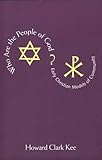Who are the people of God? : early Christian models of community / Howard Clark Kee.
Material type: TextPublication details: New Haven : Yale University Press, c1995.Description: vii, 280 p. ; 23 cmISBN:
TextPublication details: New Haven : Yale University Press, c1995.Description: vii, 280 p. ; 23 cmISBN: - 0300059523 (alk. paper)
- 9780300059526 (alk. paper)
- 270.1 20
- BV598 .K425 1995
| Item type | Current library | Collection | Call number | Status | Notes | Date due | Barcode | |
|---|---|---|---|---|---|---|---|---|
 Books
Books
|
SAIACS General Stacks | Centre for South Asia Research (CSAR) | 270.1 K26W (Browse shelf(Opens below)) | Available | TBN-OCT/2016 | 053796 |
Browsing SAIACS shelves, Shelving location: General Stacks, Collection: Centre for South Asia Research (CSAR) Close shelf browser (Hides shelf browser)

|

|

|

|
No cover image available | No cover image available | No cover image available | ||
| 270.1 H818C A people's history of Christianity Volume 1 : Christian origins / | 270.1 J45R Reading the Apostolic Fathers : | 270.1 K26B The Beginnings of Christianity: | 270.1 K26W Who are the people of God? : | 270.1 K63M Magic and paganism in early Christianity: | 270.1 K63M Magic and paganism in early Christianity: | 270.1 K89O The Old Testament since the Reformation |
Includes bibliographical references (p. 235-269) and index.
Ancient history and contemporary historiography -- Models of community in the literature of postexilic Judaism -- The community of the wise -- The law-abiding community -- The community where God dwells among his people -- The community of mystical participation -- The ethnically and culturally iclusive community -- The community models develop in the post-New Testament period -- Critical note : priority in the gospel tradition.
In this provocative book, an eminent scholar examines the complex factors that shaped Judaism and early Christianity, analyzing cardinal Judaic and Christian texts and the cultural worlds in which they were written. Howard Clark Kee's sociocultural approach emphasizes the diversity of viewpoint and belief present in Judaism and in early Christianity, as well as the many ways in which the two religions reacted to each other and to the changing circumstances of the first two centuries of the Common Era. According to Kee's interpretation of Jewish documents of the period, Jews began to adopt various models of community to bring into focus their group identity, to show their special relation to God, and to articulate their responsibilities within the community and toward the wider culture. The models they adopted - the community of the wise, the law-abiding community, the community of mystical participation, the city or temple model, and the ethnically and culturally inclusive community - were the means by which they responded to the challenges and opportunities for reinstating themselves as God's people. These models in turn influenced early Christian behavior and writing, becoming means for Christians to define their type of community, to understand the role of Jesus as God's agent in establishing the community, and to outline what their moral life and group structure, as well as their relations with the wider Jewish and Greco-Roman culture, ought to be.
There are no comments on this title.

